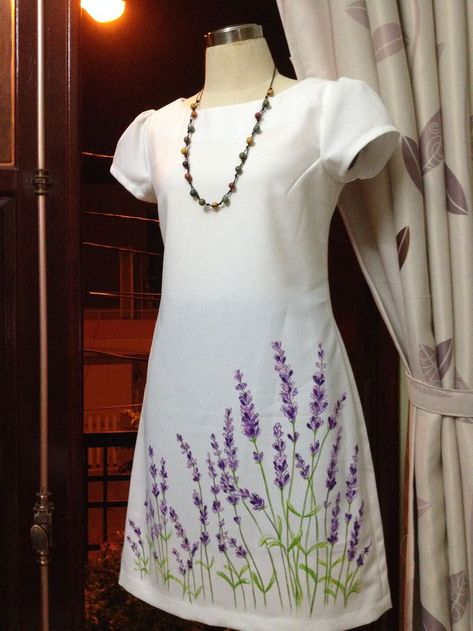Painting on Simple Dress
Painting on simple dresses is a creative and versatile technique that allows fashion designers to transform plain fabrics into unique and personalized garments. This class note explores the art of painting on simple dresses in fashion design, covering techniques, materials, design considerations, historical influences, contemporary applications, and practical insights for designers interested in incorporating painted designs into their collections.
Historical Context

The practice of painting on fabric has a rich history dating back centuries, where artisans and craftsmen used natural dyes and pigments to decorate textiles for ceremonial, decorative, and utilitarian purposes. In many cultures, hand-painted garments were symbols of status, craftsmanship, and cultural identity. From ancient civilizations to modern times, painting on fabric has evolved alongside advancements in materials and techniques, shaping the expressive possibilities of fashion design.
Techniques and Materials
1. Fabric Paints:
- Acrylic Paints: Versatile and durable, acrylic paints are widely used for painting on fabric due to their vibrant colors and ability to adhere well to textile fibers.
- Fabric Mediums: Mixed with acrylic paints to enhance flexibility and prevent stiffness after drying, allowing for comfortable wear of painted garments.
- Textile Paints: Specifically formulated for fabric, these paints offer superior wash-fastness and color retention.
2. Tools:
- Paint Brushes: Various sizes for different painting techniques—from fine details to broader strokes.
- Sponges and Stencils: Used for creating textured effects or repeating patterns.
- Palette Knives: Ideal for applying thick paint and creating impasto effects.
3. Surface Preparation:
- Pre-Washing: Ensure fabrics are washed and dried before painting to remove sizing and ensure better paint absorption.
- Surface Priming: Use fabric primer or fabric medium to prepare the surface for painting, ensuring even application and durability.
Design Considerations
1. Design Inspiration:

- Nature and Floral Motifs: Popular themes for painted dresses, offering a romantic and whimsical aesthetic.
- Geometric Patterns: Modern and minimalist designs suitable for contemporary fashion.
- Abstract Art: Expressive and avant-garde styles that push the boundaries of traditional fashion design.
2. Color Palette:
- Harmony and Contrast: Choose colors that complement each other and enhance the overall design.
- Seasonal Trends: Adapt color choices to current fashion trends and seasonal palettes.
3. Placement and Composition:
- Focus Points: Consider focal points on the dress where painted designs will attract the most attention, such as the bodice, hemline, or sleeves.
- Flow and Balance: Ensure the composition of painted elements enhances the garment’s silhouette and overall balance.
Applications in Fashion Design
1. Couture and Custom Designs:
- Bespoke Dresses: Custom-designed dresses with hand-painted motifs tailored to individual preferences and occasions.
- One-of-a-Kind Pieces: Unique garments that showcase the artistic vision and craftsmanship of the designer.
2. Ready-to-Wear Collections:
- Limited Editions: Painted dresses produced in small batches for exclusive collections, appealing to fashion-forward consumers.
- Capsule Collections: Collaborations between artists and fashion designers to create themed collections featuring painted dresses.
3. Bridal and Evening Wear:
- Wedding Gowns: Painted details on bridal dresses, adding personalization and artistic flair to traditional bridal attire.
- Evening Gowns: Statement dresses with intricate painted designs, suitable for red carpet events and gala evenings.
Contemporary Trends and Innovations
In contemporary fashion, painting on simple dresses continues to evolve with technological advancements and creative collaborations:
1. Digital Printing Integration:
- Hybrid Designs: Combine hand-painted elements with digitally printed motifs for intricate and layered designs.
- Customization: Digital tools allow for precise replication of hand-painted designs, offering customization options for consumers.

2. Sustainable Practices:
- Eco-Friendly Paints: Use of water-based and non-toxic paints that minimize environmental impact.
- Upcycling: Painting on upcycled garments or vintage dresses to create sustainable fashion pieces.
3. Cross-Cultural Influences:
- Global Inspiration: Incorporate motifs and styles from diverse cultural traditions into painted designs, promoting cultural exchange and appreciation.
Practical Insights for Designers
1. Experimentation and Prototyping:
- Mock-ups and Samples: Create prototypes to test color combinations, techniques, and durability of painted designs.
- Feedback and Iteration: Seek feedback from peers or clients to refine painted designs and ensure they meet expectations.
2. Care and Maintenance:
- Labeling Instructions: Provide care labels with instructions for washing and maintaining painted garments.
- Touch-Up Kits: Offer customers touch-up kits with extra paint and instructions for minor repairs or touch-ups.
3. Marketing and Branding:
- Storytelling: Share the inspiration behind painted designs through storytelling on social media and marketing materials.
- Artisanal Craftsmanship: Highlight the artisanal craftsmanship involved in painting each garment, appealing to consumers interested in unique, handcrafted fashion.

Conclusion
Painting on simple dresses in fashion design offers endless creative possibilities for designers to express their artistic vision and create personalized, one-of-a-kind garments. By mastering techniques, understanding design principles, and embracing innovation, fashion designers can leverage painted designs to differentiate their collections in a competitive market. As consumer preferences shift towards unique and sustainable fashion choices, painted dresses serve as a canvas for artistic expression, cultural storytelling, and individual style, bridging the gap between art and fashion in contemporary design practices.
